CMTS has a flame evaluation laboratory that complies with international standards and can offer a wide range of reaction to fire testing services to various industries in Indonesia.
Reaction to fire examines a substance’s flammability and ignitability, or its ability to contribute to blaze spread and growth instead of its capacity to resist flame passage. CMTS and the team represent a broad range of activities, everything that is carried out in specially built fire test laboratory equipment constructed to international standards, where our expert engineers can devise various structures to evaluate flame propagation in any particular circumstance.
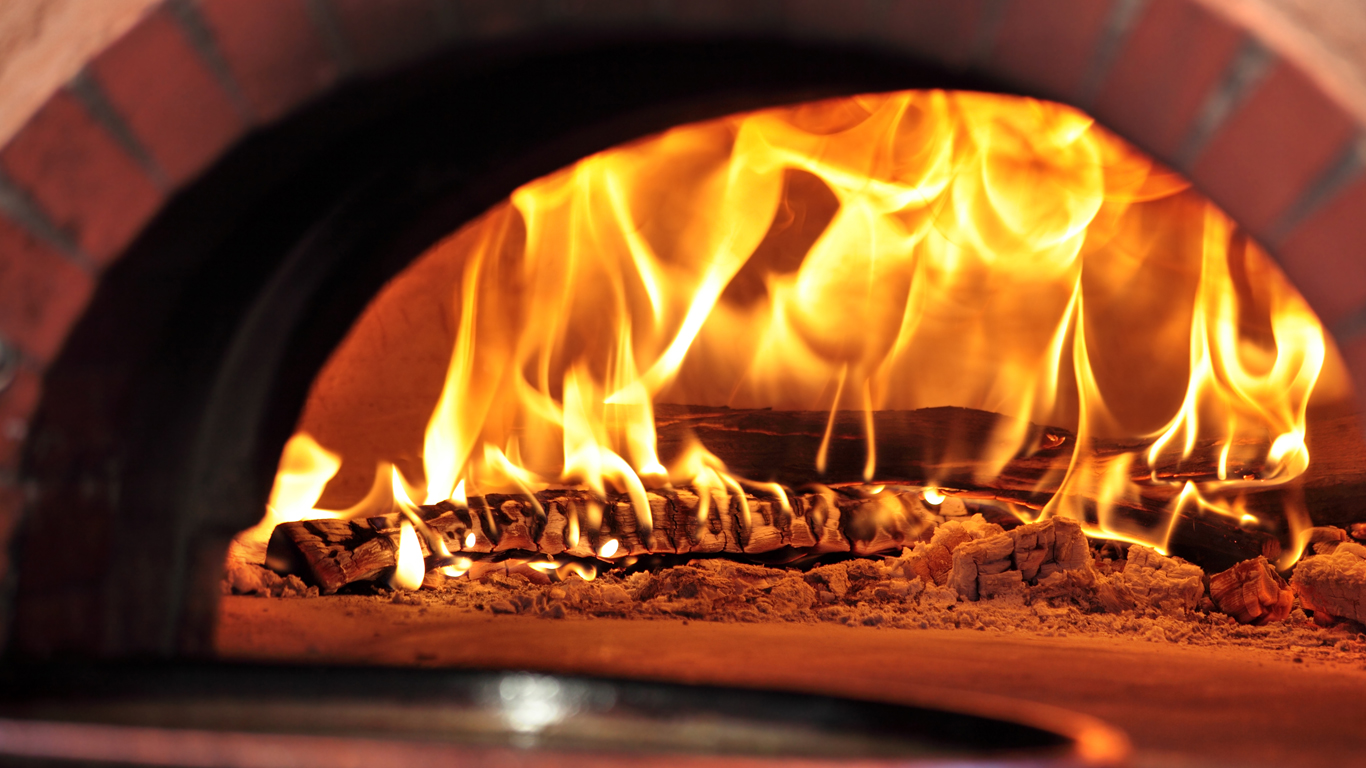
Testing an object’s reaction to fire tests features is crucial for comprehending its response in the initial phases of a blaze. This because the flammable object will influence the spread of the fire when it occurs at this stage. As a result, Indonesian businesses must understand the fire resistance properties of building materials and equipment. Conducting reaction to fire testing with CMTS amenities can provide multiple benefits, including the following:
The flame cases in Indonesia have been increasing over the years. Thus, with the existence of CMTS in the industry, we can save a lot of Indonesian lives. The power of the components used in the building's construction to endure fire is essential because it will protect the safety of the locality. This is because if a flame breaks out in the building, the components that have experienced a significant reaction to fire tests will not be expanded at a rapid or large scale. Conducting a reaction to fire test could also give individuals living within the vicinity of the blaze enough time to escape and save themselves.
The team of CMTS is very concerned about the importance of conducting reaction-to-fire testing on the materials used in the construction. This includes buildings and infrastructures, most of them have been built without any inspections of the fire's durability and resistance. thus, it is our responsibility to minimize the flame cases in Indonesia.
Imagine how significant the loss would be if a building of yours were destroyed due to fire accidents, and what are the steps that we should take to avoid that from happening? Hence, our main power provides a diverse range of safety resources that can help you safeguard your property from potentially devastating events such as flame, including reaction to fire test assessment.
By conducting the test for reaction to fire, we can help manufacturers to produce building materials that are difficult to ignite. You need to ensure that all construction materials used have high resistance to fire. So that it is also able to slow down the spread of flame to other areas. It is a priority for us to recommend our customers only use substances such as walls, roofs, floors, and bricks, which comply with safety standards. In this way, we might help on decreasing the flammability cases involving Indonesian.
CMTS offers services in carrying out reaction to fire tests on construction materials. But that is not enough, we also implement the same test on something like the furniture, marine, and mass transit sectors. Our company’s reaction to fire test assessment is associated with the Active Fire Protection System and Passive Fire Protection System.
Active fire protection methods apply steps to try to douse the flames before it spreads. For instance, portable flame extinguishers, fire hose reels, and landing valves. Active fire protection systems can have an impact on all stages of a blaze.
They can start with detection, in which an alarm is sounded to alert people to leave the building and call the fire department. Then they proceed to suppression, where they attempt to disrupt the fire’s cycle and prevent it from spreading. Finally, active fire suppression systems can help with air circulation both before and after a flame to maintain exit routes free and lower unsafe surroundings as people try to escape a building.
Active fire protection systems must be truthful, so detailed testing is required. By completing the reaction to fire test on active flame protection, it is shown that you are having a high level of commitment to your duty of taking care of your building’s maintenance safety systems. The BS 476 standard will be utilized as a reference in every operation and method used to conduct the reaction to fire test.
At CMTS, we have a team of experts who are certified, specifically in the field of fire testing services, who are capable of designing tests that meet our client’s needs and requirements while also meeting specific standards. Our capabilities and facilities enable us to produce a high-quality and potential reaction to fire tests, making sure the safety of the community and property. It is our top priority to guarantee that our clients in Indonesia could conduct business productively.
Passive fire protection systems have the same crucial and play a role to fire resistance. Passive fire protection systems are regularly built into the structure of the building. Examples, duct and damper, fire curtains and shutters, fire-resistant doors, and glass and glazing systems. The reaction to fire tests on the aid of the passive systems in isolating the structure and comprising flames in smaller places, attempting to prevent them from continuing to spread throughout the construction.
For passive fire protection systems, the controller must have a piece of expert information showing that the fire protection system utilized fulfills outlined performance criteria based on standard tests that resemble the fire conditions that may be encountered in the buildings. Throughout a standard reaction to fire test, the criteria will generally be that the safe surface would not touch a certain temperature in a specified period. The protective system must carry a pool fire test, as detailed in BS 476 ‘Fire tests on building materials and structures,’ or a jet fire test, as described in the HSE Technology Report ‘Jet Fire Resistance for Passive Fire Protection Materials.
Planning to make your building a flameproof place may seem so tricky. However, CMTS, as one of the industry’s leading fire protection companies, is ready to turn your fears into a sense of relaxation. Our Indonesian clients can focus on ensuring that their business and each of its assets are well shielded in the event of a flame by installing a passive blaze protection system which is done the reaction to fire test by our company.
The team of CMTS guarantees that our customers are always happy with the reaction to the fire test service we provide. This is because the implementation of this test will have a variety of positive effects on our customers, such as
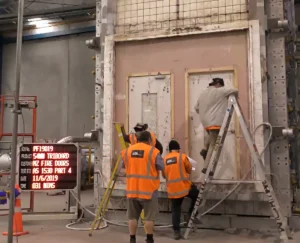
Using the BS 1363 Fire Test standard, which tests equipment, conditions, specimens, test installations, applications, procedures, performance criteria, and test reports are all covered. Conducted reaction to fire test by implementing each standard specified in BS 1363 Fire Test consistently, can help both employers and staff relax. This is because failure to comply with the Indonesian authorities’ safety standards will result in costly fines. To avoid code violations, reaction to fire tests, proper installation, inspection, and maintenance should be performed.
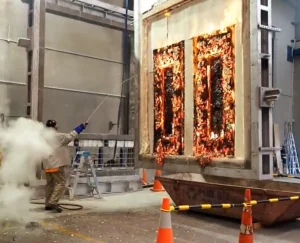
The reaction to Fire Test is conducted to evaluate the capability of a material used in the construction of a building or infrastructure to resist fire. For example, CMTS and the team frequently perform fire resistance tests on wall and partition systems to determine how long these materials can withstand fire. Furthermore, the results of our tests revealed that some wall partitions can stand up to 4 hours of fire exposure. Another example is a fire door, which is part of a building’s passive fire protection system and can withstand fire for 30 to 60 minutes, preventing the fire from spreading further.
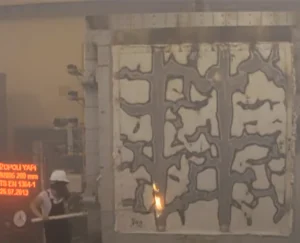
Applying BS 8458:2015 and AS 1851-2012 standards to your active and passive fire tests would save your money in the long term. By lowering the number of regular inspections and reaction to fire testing. Conduct the fire reaction test in a disciplined manner capable of identifying safety precautions that can reduce the possibility of future costly repairs. Furthermore, having a reaction to fire test on material buildings can help decrease property damages and loss of business data. This dilemma can assist Indonesian business owners in helping to ensure that they can obtain more profits while also assure that each worker’s safety is under the best oversight.
CMTS and the team will perform a reaction to fire test to determine materials’ contribution to fire development and spread rather than their capability to withstand fire passage, such as:
• BS476 Part 6 Fire Propagation Test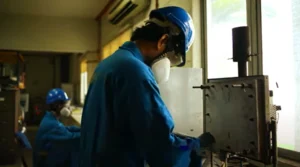
The BS476 part 6 test is done to determine the heat release output. CMTS carries the reaction to fire test to compare the performance of our test material to a non-combustible board. We will attach the specimen to the test rig and expose it to both a direct flame and a radiant heat source. We are monitoring the temperature in the test equipment’s chimney by limiting the heat released from materials. This reaction to fire test gives building occupants more time to escape from a flame incidents.

• BS476 Part 7 Surface Spread of Flame Test
CMTS using BS476 Part 7 to identify flame spread across a specimen. Our experts will carry visual observations to evaluate how far the flames have spread along the reference line drawn on the reaction to fire test. The specimen only counts toward classification if it flames on this reference line. The greater the spread of the flame, the worse reaction to the fire test’s result.
Accreditation for Fire Protection from the Malaysian Standards Department under the National Laboratory Accreditation Scheme and recognition from Underwriter Laboratories under the CMTS demonstrate our competence. Additionally, our furnace is specially constructed to meet the requirements of world standards compliance and to fulfill the fire resistance conditions. We are dedicated to making sure that your business can operate at a peak level by utilizing our professional experience, expertise, and high-caliber facilities that meet international standards.
Fill out a quick inquiry form to get in touch with us for assistance with fire protection or flammability testing
